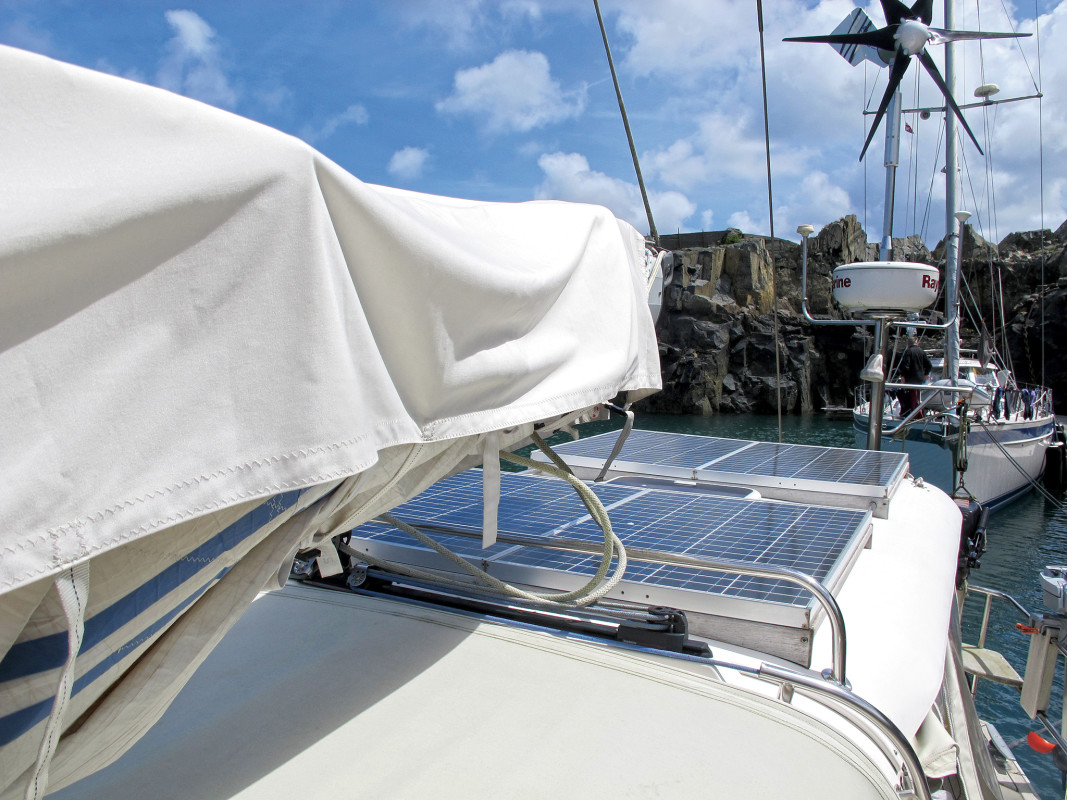

Picture: Nigel Calder
Sixteen years in the past, I put in photo voltaic panels on my boat. On the time, the height effectivity at changing daylight to electrical energy was round 16%. Right this moment’s panel applied sciences allow considerably extra vitality to be harvested from a given floor space, boosting effectivity as excessive as 24%—a 50% improve. Taken with different advances, notably how panel output is managed, we’ve got a qualitative enchancment in the advantages photo voltaic can deliver to a ship’s vitality techniques.
Conventional Panel Applied sciences
One factor that hasn’t modified is the usage of considered one of three silicon-based applied sciences: monocrystalline, polycrystalline, and thin-film.
Monocrystalline cells are created by inserting a silicon crystal “seed” in a vat of molten silicon after which slowly withdrawing the seed. The molten silicon types a strong single crystal cylinder across the seed. The cylinder is squared off and sliced into wafers—the fundamental constructing block of a cell. A good quantity of the silicon cylinder turns into waste, driving up the associated fee.
Polycrystalline (multicrystalline) cells additionally begin as a seed in a vat of molten silicon. As soon as cooled and hardened, the ensuing square-sided multicrystal strong is sliced into wafers. In contrast with cylindrical, monocrystalline ingots, the square-sided ingots scale back waste and are considerably cheaper.
In principle, a monocrystalline cell is extra environment friendly at changing daylight into electrical vitality than a polycrystalline cell. In apply, sufficient components come into play {that a} high-grade polycrystalline cell in a well-built panel can be extra environment friendly, and maintain that effectivity longer, than a low-grade monocrystalline cell in a poorly constructed panel.
Skinny-film panels—much less environment friendly than poly or monocrystalline-cell panels and inclined to moisture intrusion—are not often seen on boats nowadays.
The wafer of silicon in a photo voltaic cell is modified to create electrical energy when uncovered to daylight. One pole of {the electrical} circuit usually consists of three to 5 silver busbars embedded on the floor of the cell with a mass of barely seen fingers feeding into the busbars. The fingers gather the present generated by the cell, feeding it to the busbars. {The electrical} circuit’s different pole is on the underside of the cell, consisting of a conductive floor, usually a skinny layer of aluminum.
Every cell produces round 0.6v to 0.7v in daylight. Cells are linked in collection to spice up the voltage (for a nominal 12v panel, there can be anyplace from 32 to 40 cells in collection). The collection connections are made by a strip of copper soldered to the busbars on high of 1 cell and linked to a different strip of copper soldered to the again floor of the adjoining cell. Cells and wiring are laminated between sheets of plastic (versatile or semi-flexible panels) or between glass and plastic (inflexible panels).
The ampere output of a panel is a operate of cell dimension (floor space) and cell high quality. A panel with 32 cells in collection will produce the identical ampere output as one with 100 comparable cells in collection, however the latter could have a a lot larger voltage. The rated energy is the amperage multiplied by the voltage.

Picture: Nigel Calder
Innovating Cell Applied sciences
The Maxeon monocrystalline cell from SunPower, typically known as Interdigitated Again Contact (IBC) expertise, is completely different. The wafer’s constructive and adverse electrodes are each on the bottom of the cell, eliminating the grid on the highest. On the again of the cell, the standard skinny aluminum layer is changed with a extra sturdy copper layer, enhancing electrical efficiency and eliminating the corrosion related to aluminum.
As a result of the constructive and adverse electrodes are on the again of a Maxeon cell, the skinny and weak top-of-one-cell-to-the-bottom-of-the-next-cell connection on standard series-wired cells is changed by a extra rugged edge-to-edge connection (it appears to be like like, and is named, a dogbone). The skinny silver fingers printed on the entrance facet of all different cells and the related busbars are eradicated, together with quite a few soldered connections.
SunPower claims the assorted modifications in its cells and panels eradicate 85% of the failures in standard designs, which, it contends, are due primarily to corrosion and electrical breaks. Within the laboratory, SunPower cells have achieved efficiencies above 24%. SunPower manufactures its personal panels from these cells and provides cells to premium marine photo voltaic panel producers equivalent to Solbian (in Italy) and Solara (in Germany).
One other uncommon method to cell building is the HIT cell from Panasonic. HIT stands for Heterojunction with Intrinsic Skinny layer. HIT cells mix monocrystalline expertise with ultrathin amorphous silicon layers to enhance general effectivity. Within the laboratory, Panasonic has achieved efficiencies above 25%. Together with SunPower IBC cells, Panasonic HIT cells are acknowledged because the highest-power business silicon cells obtainable.
HIT cells use a traditional grid construction with its inherent weaknesses, however these might be considerably mitigated with the Merlin Superior Metallization Know-how (MTAT) grid. It may be used on all cell varieties aside from SunPower IBC cells.
The standard silver fingers are first screen-printed onto cells. Rather than the busbars, the MTAT grid is added. The first conductors are tapered from one finish to the opposite, gaining in cross-sectional space from one facet of a cell to the opposite as they gather an increasing number of present from the cell. The conductors snake barely forwards and backwards, making a spring impact that absorbs differential enlargement and contraction with adjustments in temperature. This impact is especially pronounced on the in any other case weak cell-to-cell collection connections, lowering the danger of fracture.
The MTAT copper grid construction provides stability to the brittle silicon cell wafers. It minimizes the failures related to conventional soldered conductors. Within the occasion of microscopic cell fractures that may severely influence cell efficiency, the a number of conductors and connection factors (the entrance of every cell has round 2,000) decrease the lack of panel output. An MTAT grid on a HIT cell is an impressive mixture of effectivity and ruggedness.

Picture: Nigel Calder
Test the Guarantee
Buying marine photo voltaic panels is a case of purchaser beware. After manufacture, cells are examined and sorted based mostly on their efficiency. Cells that look equivalent fluctuate significantly in efficiency, and there might be minute cracks and different flaws in lower-grade cells that speed up efficiency degradation over time. These lower-grade cells will doubtless value a fraction of high-grade cells, letting panel producers produce less expensive panels however with decreased efficiency.
Photo voltaic panels in house energy functions and tied to the electrical energy grid should meet varied requirements, however the identical is just not true for off-grid and marine functions, the place third-party testing to confirm claims isn’t required. Panel producers have been identified to cite the cell effectivity of high-grade cells from a producer equivalent to SunPower, when in actual fact they’re utilizing considerably much less environment friendly, lower-grade cells from the identical producer.
Regardless of how environment friendly the cells, if a panel is assembled from unsuitable supplies, is poorly constructed, is broken in delivery, dealing with, and set up, has inadequately sealed wiring connections, or is linked to the boat with undersized wiring, it should carry out poorly and sure fail prematurely. It’s not uncommon to see low-cost photo voltaic panels fail in as little as two years.
indication of high quality is the guarantee—what number of years it’s legitimate, and what it covers in these years (e.g., full substitute for failures and lack of output, or pro-rated substitute). Notice that almost all inflexible family panels carry no guarantee when utilized in marine and cellular installations.

Picture: Nigel Calder
Set up Issues
With Bruce Schwab of Ocean Planet Vitality, I performed shading assessments. We discovered {that a} onerous shadow has the impact of knocking out a share of the panel’s output equal to the share shading of a single cell: shading one quarter of a single cell knocks out one quarter of the panel’s output. Smooth shadows (for instance, from rigging at far from the panel) have nowhere close to the identical impact.
When cells are shaded, they eat energy from nonshaded cells in a collection string. Within the case of onerous shadows, shaded cells can turn into scorching sufficient to soften plastic instances and even begin fires. To stop scorching spots, bypass circuits and bypass diodes are sometimes put in at strategic factors. If a cell turns into shaded, back-feeding of the shaded cell is restricted to that a part of the string between the closest bypass diodes.
Bypass diodes must be put in with any collection string of 50-60 watts or better. This can restrict the utmost obtainable back-feeding vitality to ranges that won’t trigger extreme heating or cell burning. The diodes might be constructed right into a panel or mounted externally.
Though diodes in operation create a voltage lack of as much as 0.7v, in regular panel operation bypass diodes aren’t a part of the conducting circuit and don’t eat vitality or diminish panel output. Nevertheless, if a cell is shaded and the diodes turn into a part of the circuit, the mixed impact of the shading and diodes will dramatically scale back the output voltage.
If panels are wired in parallel to a typical voltage regulator and one is partially shaded, the higher-performing panel will back-feed the lower-performing panel. To stop this, blocking diodes are required at panel outputs. These completely wired parts will create a everlasting lack of voltage and also will take in a really small quantity of vitality. To keep away from this everlasting inefficiency, add particular person photo voltaic regulators to every panel to optimize every panel’s output.

Picture: Nigel Calder
Advances in Voltage Regulation
To cost a battery, we should elevate the voltage above the battery’s at-rest voltage. This is the reason a 12v photo voltaic panel has anyplace from 32 to 40 cells in collection, with every producing between 0.6v and 0.7v. In daylight and disconnected from a battery, a voltmeter throughout the output terminals of a 12v photo voltaic panel will usually learn something from 16v to greater than 20v.
The upper the voltage, the better the flexibility to take care of charging voltages within the face of voltage losses from connections and wiring, and losses by diodes and regulators. However now, if a photo voltaic panel is unregulated, the output of even a reasonably sized panel is ample to destroy a battery over time by overcharging. We’d like a voltage regulator on all however the smallest panels. These regulators additionally incorporate a diode that forestalls the battery from back-feeding a photo voltaic panel in a single day or when the panel is severely shaded.
Two sorts of regulators are generally used: Pulse Width Modulated (PWM) and Most Energy Level Monitoring (MPPT).
A PWM regulator feeds panel output immediately by to a battery. The battery determines the photo voltaic panel’s output voltage. A considerably discharged battery will initially settle for every little thing the photo voltaic panel can throw at it. The regulator will do nothing. Because the battery turns into extra absolutely charged, its voltage creeps up. At a pre-determined acceptance voltage, the regulator kicks in to carry the voltage at this stage. It does this by disconnecting and reconnecting the photo voltaic panel at a excessive frequency, pulsing the battery with charging present. Because the battery state of cost climbs and its potential to soak up charging present continues to drop, the regulator’s off durations get longer than the on durations; that is the heartbeat width modulation. When the battery is absolutely charged, the regulator journeys to a decrease voltage float setting.
In numerous gentle circumstances, the output voltage at which probably the most vitality might be extracted from a photo voltaic panel varies. As a result of the output voltage of a panel linked to a PWM regulator is managed by the battery voltage, the regulator can’t modify the voltage to optimize panel output.
An MPPT regulator, however, successfully disconnects the photo voltaic panel from the battery, determines the optimum panel voltage within the given gentle circumstances, and masses the panel in a fashion that holds it at this voltage.
In less-than-ideal gentle circumstances, an MPPT regulator can push the output of a panel up by as a lot as 30% in comparison with a PWM regulator. Nevertheless, the electronics within the MPPT regulator take in vitality and negate a few of this acquire. The most effective at the moment are over 95% environment friendly, with some claiming greater than 99% peak effectivity.

Picture: Nigel Calder
We now have a current adaptation of MPPT expertise. Historically, all regulators have required a panel voltage that’s above battery voltage, therefore the 32 to 40 cells in a 12-volt panel. In smaller panels, cells should be lower as much as obtain the requisite quantity in collection, lowering panel effectivity. We now have MPPT regulators that may increase voltage. We will put as many full-sized cells in a panel as will match that specific dimension, after which increase the voltage as excessive as we wish—for instance, 10 cells with a nominal voltage of 6v to 7v boosted to ranges that can cost a 48v battery financial institution.
The hyperlink between cell numbers and battery voltage has been damaged, giving us one other important enchancment in efficiency.
With PWM regulation, it’s common to wire a number of panels in parallel to a single regulator, with blocking diodes to forestall panels back-feeding each other. Though this can be completed with MPPT regulators, it undermines the advantages of the MPPT expertise, particularly if the panels are in numerous gentle circumstances. To totally optimize panel output, a separate MPPT regulator must be used on every panel.
Notice that there’s usually a comparatively lengthy cable run between photo voltaic panels, regulators, and batteries. These cables should be sized to attenuate voltage losses, and any cabling that attaches on to the panels and is within the open air must be daylight, UV, and ozone resistant.
Conclusions
The important thing to an efficient, optimized, photo voltaic set up on a ship is to purchase high quality panels with a superb marine guarantee from a acknowledged marine vendor. Set up them with care, offering satisfactory assist in a location that limits shading. Be certain that the wiring is sized to attenuate voltage losses and that the connections are watertight. Use panels with full-sized cells. Add an MPPT regulator to every panel with a lift functionality if crucial. The outcome must be an set up that offers no less than a decade of service with minimal degradation in output.
Will increase in effectivity mixed with MPPT controllers, and not too long ago increase controllers, has reworked what we are able to count on by way of output. On many boats, particularly catamarans, it’s doable to maintain up with all home masses, as much as and together with modest air con, regularly eliminating the necessity for a generator or lengthy hours of battery charging at anchor.
The additional offshore you plan to sail, the better the life-style advantages from putting in as a lot photo voltaic as doable.
SAIL Contributing Editor Nigel Calder might be greatest often called the writer of the definitive Boatowner’s Mechanical and Electrical Guide and Marine Diesel Engines. A longtime member of the American Boat and Yacht Council, his boathowto.com offers reliable technical data for sailors. He and his spouse, Terrie, have sailed from the Faroe Islands to Portugal, the Bahamas, the U.S. East Coast, and Caribbean, and he’s written guides together with Nigel Calder’s Cruising Handbook: A Compendium for Coastal and Offshore Sailors.

Might 2024
Trending Merchandise
[product_category category=”trending” per_page=”8″ columns=”2″ orderby=”date” order=”desc”].
